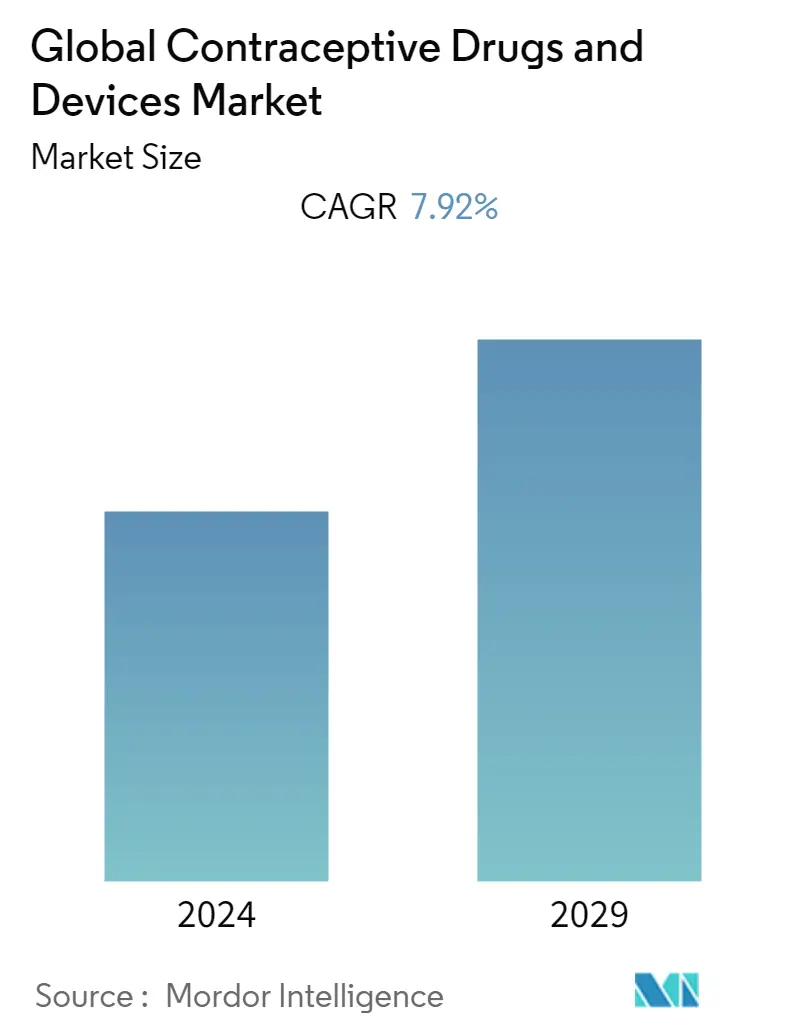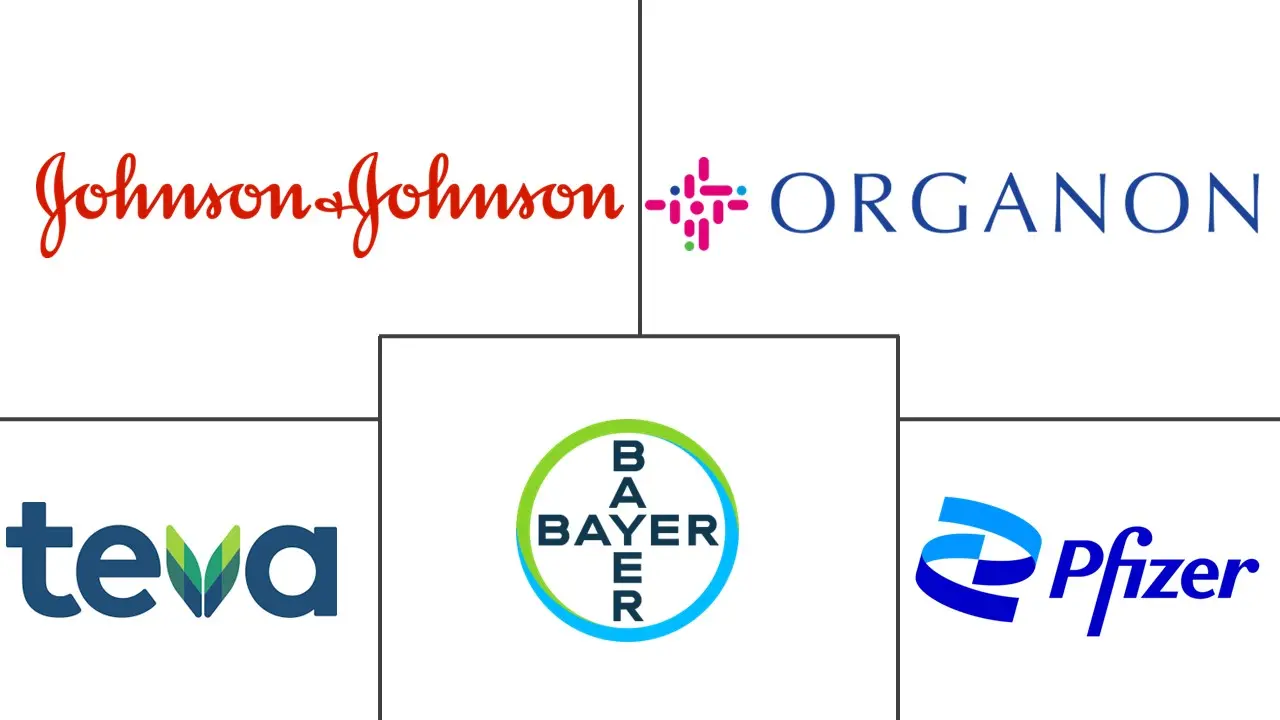Market Size of Global Contraceptive Drugs and Devices Industry

| Study Period | 2019 - 2029 |
| Base Year For Estimation | 2023 |
| CAGR | 7.92 % |
| Fastest Growing Market | Asia-Pacific |
| Largest Market | North America |
| Market Concentration | Medium |
Major Players
*Disclaimer: Major Players sorted in no particular order |
Contraceptives Drugs Devices Market Analysis
The contraceptive drugs and devices market is expected to register a CAGR of 7.92% during the forecast period.
The restrictions imposed by the government have significantly impacted the growth of the studied market during the initial period of the pandemic. For instance, according to an article published in Contraceptives and Reproductive Medicine in March 2022, it has been observed that the use of long-acting contraceptives decreased, with implants by 76%, intrauterine systems by 79%, and intrauterine devices by 76%. Similarly, according to United Nations Population Fund, in March 2021, women had difficulty accessing contraception nine times, resulting in an almost doubling of unexpected births, from 1.3% pre-lockdown to 2.1% post-lockdown. Thus, there was a significant impact on the contraceptive drugs and devices market due to the COVID-19 pandemic. However, since the lockdown restrictions were lifted, the industry has been recovering well. For instance, in October 2022, TTK Healthcare Ltd in India reported a more than twofold increase in quarterly profit, boosted by increased sales of medical devices and contraceptives. Revenue from its protective devices division, which includes the Skore condom brand, increased by over 33% as new items were introduced. It also received a contract to deliver contraceptive devices to an international organization until July 2023. Such instances are expected to boost the growth of the market over the forecast period.
Certain factors that are propelling the market growth are increasing incidences of sexually transmitted diseases, an increasing rate of unintended pregnancies, and rising government initiatives. Unwanted pregnancies are becoming more prevalent globally and are a major cause for concern. For instance, according to the United Nations Population Fund, in March 2022, unintended pregnancies accounted for about half of all pregnancies worldwide, with 121 million occurring each year. As per the same source, over 60% of unplanned pregnancies end in abortion, with an estimated 45% of all abortions being unsafe, resulting in 5%-13% of all maternal fatalities, putting the world's capacity to meet the "Sustainable Development Goals" at risk. Additionally, according to the article published in the BMC Pregnancy and Childbirth 2021, unintended pregnancies affect approximately 85 million women worldwide, with India accounting for more than one in every seven of these cases. In addition, as per the same source, Uttar Pradesh, India's most populous state (population of approximately 200 million), has twice the unwanted fertility rate as compared to the rest of the country. Thus, the rising number of unintended pregnancies is expected to boost the demand for contraceptive drugs and devices, which is anticipated to boost market growth over the forecast period.
In addition, the rising prevalence of sexually transmitted diseases among the population is expected to increase the market growth. For instance, according to the report published by the Centers for Disease Control and Prevention in April 2022, it reported that around 133,945 cases of all stages of Syphilis were noted, which includes 41,655 cases of primary and secondary Syphilis, which is considered the most infectious stages of the disease. It also reported an increase of 6.8% in Syphilis in 2020. Additionally, according to the data published by the World Health Organization in November 2021, it has been observed that around 374 million new infections with one of four sexually transmitted diseases - chlamydia (129 million), gonorrhea (82 million), Syphilis (7.1 million) and trichomoniasis (156 million) were recorded in 2020. Thus, the rising burden of sexually transmitted diseases is expected to increase the demand for contraception to avoid getting diseases, thereby propelling market growth.
Furthermore, the countries and their governments have recognized the need to curb the increase in unplanned pregnancies and have launched numerous campaigns to educate people and prevent the spread of unplanned pregnancies and abortions. The usage of contraceptive pills is one of them. The fundamental right to privacy guaranteed by the United States Constitution includes the freedom to obtain and use contraceptives. For instance, the United States Agency for International Development (USAID) promotes and supports voluntary family planning and reproductive health initiatives in approximately 40 countries worldwide. Additionally, in March 2022, National Chlamydia Screening Program (NCSP) was organized in the United Kingdom. The program's main aim is to reduce the risk of untreated chlamydia infection. This program also focused on reducing the time to test results and treatment and re-testing after treatment. The program is also changing from prevention and control to focusing on reducing the harms of untreated chlamydia infection by primarily screening women and girls. Thus, government initiatives are also promoting the use of contraceptive methods to avoid unnecessary births and abortions.
Thus, all aforementioned factors, such as rising in the prevalence of sexually transmitted diseases and government initiatives, are expected to propel the growth of the market. However, the high cost of devices and treatment and side effects associated with the use of contraceptive drugs and devices are some of the factors that are likely to impede market growth over the forecast period.
Contraceptives Drugs Devices Industry Segmentation
As per the scope of the report, contraception is defined as the intentional prevention of conception through the use of various devices, sexual practices, chemicals, drugs, or surgical procedures to prevent a woman from becoming pregnant and avoid the transmission of sexually transmitted diseases. These devices and drugs function by acting as a physical barrier between the sperm and ovum or by changing the mechanism of ovulation. The Contraceptive Drugs and Devices Market is segmented by Products (Drugs (Oral Contraceptives, Topical Contraceptives, and Contraceptive Injectables), Devices (Condoms, Diaphragms, Cervical Caps, Sponges, Vaginal Rings, IUDs, and Other Devices)), Gender (Male and Female), and Geography (North America, Europe, Asia-Pacific, Middle-East and Africa, and South America). The market report also covers the estimated market sizes and trends for 17 different countries across major regions globally. The report offers the value (in USD million) for the above segments.
| By Products | |||||||||
| |||||||||
|
| By Gender | |
| Male | |
| Female |
| Geography | ||||||||
| ||||||||
| ||||||||
| ||||||||
| ||||||||
|
Global Contraceptive Drugs and Devices Market Size Summary
The contraceptive drugs and devices market is poised for significant growth, driven by a combination of factors including the rising prevalence of unintended pregnancies and sexually transmitted diseases, as well as supportive government initiatives. The market experienced a temporary setback during the COVID-19 pandemic due to restricted access to contraceptive methods, but has since shown resilience and recovery. The increasing adoption of contraceptive methods, particularly among women, is a key driver of market expansion. This growth is further supported by strategic business activities such as product launches and partnerships, which are enhancing the availability and variety of contraceptive options in the market.
North America is expected to lead the market, supported by a robust healthcare infrastructure and a high rate of contraceptive adoption. The region's growth is also fueled by the rising incidence of unwanted pregnancies and sexually transmitted diseases, prompting increased demand for contraceptive solutions. Additionally, government and organizational initiatives aimed at improving family planning and reproductive health are contributing to market growth. The market remains fragmented, with major players like Bayer AG, Pfizer Inc., and Merck & Co. Inc. actively participating in both domestic and international markets. These companies are focusing on innovation and strategic collaborations to capture a larger share of the growing market.
Global Contraceptive Drugs and Devices Market Size - Table of Contents
-
1. MARKET DYNAMICS
-
1.1 Market Overview
-
1.2 Market Drivers
-
1.2.1 Increasing Incidence of the STDs
-
1.2.2 Increasing Rate of Unintended Pregnancies
-
1.2.3 Rise in Government Initiatives
-
-
1.3 Market Restraints
-
1.3.1 High Cost of Devices and Treatment
-
1.3.2 Side Effects Associated with the Use of Contraceptive Drugs and Devices
-
-
1.4 Porter Five Forces
-
1.4.1 Threat of New Entrants
-
1.4.2 Bargaining Power of Buyers/Consumers
-
1.4.3 Bargaining Power of Suppliers
-
1.4.4 Threat of Substitute Products
-
1.4.5 Intensity of Competitive Rivalry
-
-
-
2. MARKET SEGMENTATION (Market Size by Value in USD million)
-
2.1 By Products
-
2.1.1 By Drugs
-
2.1.1.1 Oral Contraceptives
-
2.1.1.2 Topical Contraceptives
-
2.1.1.3 Contraceptive Injectable
-
-
2.1.2 By Device
-
2.1.2.1 Condoms
-
2.1.2.2 Diaphragms
-
2.1.2.3 Cervical Caps
-
2.1.2.4 Sponges
-
2.1.2.5 Vaginal Rings
-
2.1.2.6 IUD
-
2.1.2.7 Other Devices
-
-
-
2.2 By Gender
-
2.2.1 Male
-
2.2.2 Female
-
-
2.3 Geography
-
2.3.1 North America
-
2.3.1.1 United States
-
2.3.1.2 Canada
-
2.3.1.3 Mexico
-
-
2.3.2 Europe
-
2.3.2.1 Germany
-
2.3.2.2 United Kingdom
-
2.3.2.3 France
-
2.3.2.4 Italy
-
2.3.2.5 Spain
-
2.3.2.6 Rest of Europe
-
-
2.3.3 Asia-Pacific
-
2.3.3.1 China
-
2.3.3.2 Japan
-
2.3.3.3 India
-
2.3.3.4 Australia
-
2.3.3.5 South korea
-
2.3.3.6 Rest of Asia-Pacific
-
-
2.3.4 Middle East & Africa
-
2.3.4.1 GCC
-
2.3.4.2 South Africa
-
2.3.4.3 Rest of Middle East & Africa
-
-
2.3.5 South America
-
2.3.5.1 Brazil
-
2.3.5.2 Argentina
-
2.3.5.3 Rest of South America
-
-
-
Global Contraceptive Drugs and Devices Market Size FAQs
What is the current Global Contraceptive Drugs and Devices Market size?
The Global Contraceptive Drugs and Devices Market is projected to register a CAGR of 7.92% during the forecast period (2024-2029)
Who are the key players in Global Contraceptive Drugs and Devices Market?
Bayer AG, Teva Pharmaceutical Industries Ltd, Johnson and Johnson, Organon and Pfizer Inc. are the major companies operating in the Global Contraceptive Drugs and Devices Market.

